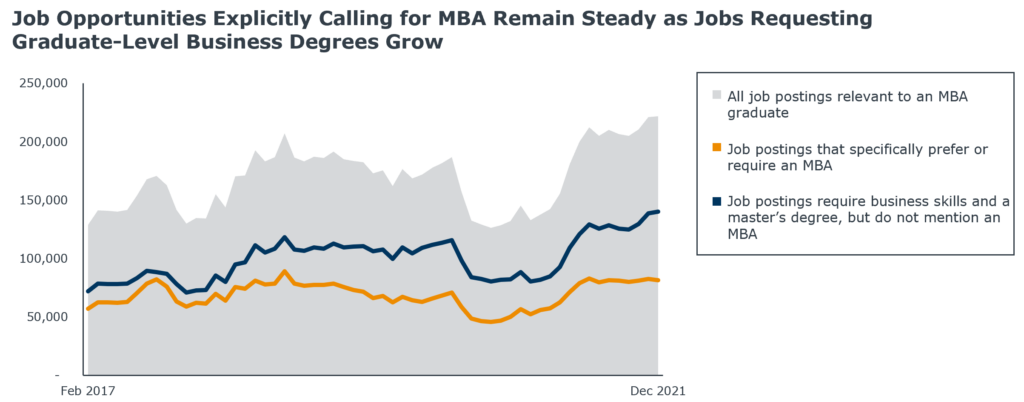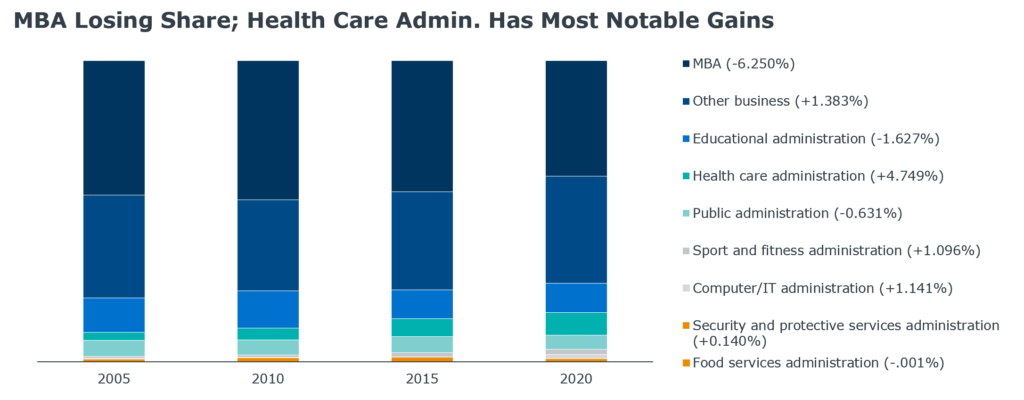MBA Program Assessment
This outlines key takeaways from EAB's MBA research and provides you an opportunity to request a customized report on your institution's MBA program.
Amid an evolving market, outdated MBA programs are losing prospective enrollment to more student-aligned rivals. The employer and student demand remains, meriting schools’ continued investment in the MBA, but increasing competition requires careful attention to program design. Programs must adapt to today’s MBA student or risk losing them to alternatives ranging from other graduate business degrees to nondegree offerings.
Today's MBA student
-
Balances part-time education alongside personal and professional responsibilities
-
Expects flexibility and is significantly experienced in virtual education or work
-
Seeks faster goal attainment by applying skills and earning credentials quickly
-
Aims to personalize their education to achieve their individual goals
-
Encounters significant choice in advanced or alternative business education
Employers demonstrate sustained market demand for MBAs, and students can expect a positive return on their educational investment
The growing employer demand for professionals with graduate business education, and sustained demand for professionals with MBAs specifically, indicates continued need for MBA education. Graduates also continue to experience attractive rewards for their education, such as higher median salaries than most master’s degree graduates.
- MBA salary premium over all master’s level salaries: +$28K
- Median MBA base starting salary: $85K

Growing competition from alternative business education presents less threat than feared but suggests needed changes to MBA program design
While MBA alternatives continue to emerge, none have yet captured significant segments of the MBA audience. Competition from core accounting, finance, and marketing programs has barely affected the MBA’s share of business degree conferrals.
Emerging MBA-adjacent fields such as health care administration or data analytics introduce a more perceptible market impact, but ultimately remain small when compared to the size of the MBA. These programs do, however, typically allow for a more personalized education with a quicker time to completion than a traditional MBA which can be an attraction.

Design programs for adult student needs: EAB’s student-centric guide will help you determine the audience your program will serve, and then build the offering to meet their needs.
More dramatic disruption from non-degree and non-institutional competitors responds to student need for more accessible and lower-cost education
The greatest competition facing MBAs today, however, comes from other more innovative and student-centered MBAs—the oft-discussed iMBA from the University of Illinois but also less-cited programs at regional institutions that have leveraged fast-paced, online programs for tremendous growth.
Opportunities and threats of alternative credentials: Continuing education leaders are concerned that traditional approaches to alternative degrees are being disrupted, potentially replaced altogether. But college and university leaders are also looking to the market for revenue growth and diversification.
MBAs require investment and attention to remain attractive given growing competition within the market and evolving student demands
-
Admission requirements
Minimize admissions requirements, focusing on those essential to students’ program success and advertising acceptable substitutions.
-
Content and customization
Maximize curricular opportunities for personalization and specialization, emphasizing in-demand skills including STEM topics.
-
Speed to completion
Enable completion within 18 months, or shorter if possible.
-
Flexibility
Offer predominantly online, asynchronous education, with occasional in-person or online synchronous networking opportunities.
3 ways to recruit MBA students in a challenging market: Given today’s market challenges, it’s more important than ever that business schools develop marketing campaigns that communicate the value of the MBA—and design MBA programs to best meet students’ needs.